Gazette Firsts: The history of The Gazette and monarch funerals

As the official public record since 1665, The Gazette has been recording royal events for over three centuries. As part of our 'Gazette Firsts' series, we look through the archives at monarch funerals, as described in The Gazette.
The Gazette and monarch funerals
Throughout its history, The Gazette has played a significant part in keeping the public informed about the monarchy. As such, it has recorded funerals for British monarchs since its inception in 1665. The Gazette has reported the ceremonial for all but three former sovereigns since 1665, as James II died in exile in France, George I died on his way to Hanover, and Edward VIII abdicated before he died.
Charles II
The Gazette was first published on 15 November 1665 after King Charles II relocated his court to Oxford to escape the Great Plague in London (Gazette issue 1). With exiled courtiers unwilling to even touch London newspapers for fear of infection, Charles II ordered a newspaper to be printed at the University Press and The Oxford Gazette (soon to be renamed The London Gazette) was born.
Charles II died on 6 February 1685 (Gazette issue 2006). The Gazette explained that King Charles fell ill on Monday 2 February 1685 and expired a few days later, when the late King’s brother, James II and VII ascended the throne.
The royal funeral service for Charles II took place on 14 February 1685, at which the Chief Mourner was King James’s son-in-law, Prince George of Denmark. The Gazette describes how the royal body was carried in procession “under a velvet canopy, born by Gentlemen of the Privy-Chamber” to Westminster Abbey before it was “interred in a vault under the East-end of the South lsle” in King Henry VII’s Chapel (Gazette issue 2008).
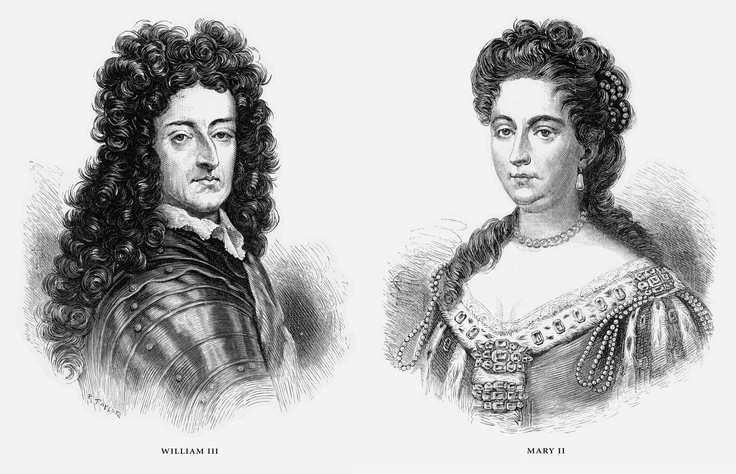
Mary II
Following James II’s deposition in the Glorious Revolution of 1688, his daughter Mary II and her husband William III were crowned Queen and King of England and Ireland on 11 April 1689 (Gazette issue 2444).
Mary died of smallpox at Kensington Palace on 28 December 1694. Her funeral took place on 5 March 1695 and for the first time The Gazette published the “Form of the Proceeding to the funeral” which went “from the Royal Palace of Whitehall to the Collegiate Church at Westminster” (Gazette issue 3059). The Gazette describes how the royal body was carried “in an open Chariot, drawn by eight Horses” and “the Sceptres, Orb and Crown upon a Purple Velvet Cushion” were placed the coffin.
William was not in attendance when Mary was buried in the south aisle of Henry VII's Chapel.
William III (of England and Ireland) and II (of Scotland)
Mary’s death meant William III ruled solo until his death at Kensington Palace on the morning of 8 March 1702. William suffered a broken collarbone after falling off his horse who had stepped in a molehill. Against doctor’s advice, William travelled to Kensington Palace and developed pneumonia, passing soon after.
William’s burial took place at Westminster Abbey on 12 April 1702 (Gazette issue 3800). There was a long carriage procession from Kensington Palace before William was buried with his wife in a vault beneath the south aisle of Henry VII's Lady Chapel, close to his mother's grave.
Anne
Upon the death of her sister’s husband, Queen Anne took the throne with her coronation taking place on 23 April 1702 (Gazette issue 3804). She died 12 years later at Kensington Palace on 1 August 1714.
The late Queen’s “private” funeral was recorded in the official public record with The Gazette describing that the procession proceeded to Westminster Abbey with “one of great Guns at the Tower firing once every Minute” (Gazette issue 5254). The service was performed by the Bishop of Rochester, Dean of Westminster and afterwards she was interred in a large coffin “in the same Vault with their late Majesties King Charles the Second, King William and Queen Mary, and his Royal Highness Prince George of Denmark.”

George II
Due to the Act of Settlement and the fact that Anne had no surviving children, following her passing the next King of Britain was her cousin George I. However, during a trip to Hanover, George I suffered a stroke and died on 11 June 1727. His son, George II was crowned alongside his wife, Caroline of Ansbach, during a coronation on 11 October 1727 (Gazette issue 6614)
George II would rule for over three decades before dying of an aortic dissection on 25 October 1760 (Gazette issue 10046). His funeral took place on 11 November of the same year where The Gazette described proceedings with a ceremonial edition (Gazette issue 10049).
The Gazette details the order in which the procession moved from the Prince’s Chamber at the Palace of Westminster to Westminster Abbey and describes the Royal Body being “carried by Twelve Yeomen of the Guard, covered with a large Pall of Purple Velvet, and lined with Purple Silk, with a fine Holland Sheet, adorned with ten large Escutcheons of the Imperial Arms painted on Sattin, under a Canopy of Purple Velvet.”
As George’s body was being interred in the vault he had newly constructed for Caroline's burial, the Anthem was sung by the choir and the Garter King of Arms proclaimed His late Majesty’s styles: “King of Great Britain, France and Ireland, Defender of the Faith, and Sovereign of the most Noble Order of the Garter, Duke of Brunswick and Lunenburgh, Arch-Treasurer and Elector of the Holy Roman Empire.”
George left instructions for his coffin to lay next to his late wife Caroline’s coffin, and for the sides of both coffins to be removed so that their dust could mingle. George II was the last monarch to be buried at Westminster Abbey, with all succeeding sovereigns buried at Windsor Castle.
George III
George II’s eldest son Frederick, Prince of Wales died suddenly in 1751, nine years before his father, and George II’s eldest grandchild Augusta was unable to succeed to the Crown because of her gender. Therefore the King was succeeded by his grandson, George III, whose coronation took place on 22 September 1761 (Gazette issue 10142). He would go on to reign the country for almost six decades, longer than any monarch before him, before expiring at Windsor Castle on 29 January 1820.
The funeral took place on 16 February 1820 (Gazette issue 17567)*, following a lying in state in the Royal Apartments of Windsor for two days, where the public were allowed to view the coffin. Upon the procession reaching the Great Gate of St George’s Chapel in Windsor, the King’s body was received by the Dean of Windsor and the organ played “I am the resurrection and the life saith the Lord”.
The late King’s second son, His Royal Highness the Duke of York, was Chief Mourner and stood at the head of the coffin for the service. George was buried in the chamber beneath the chapel alongside other members of his family.
*This issue of The Gazette is currently only available offline in PDF format. Please contact our customer services for further details.
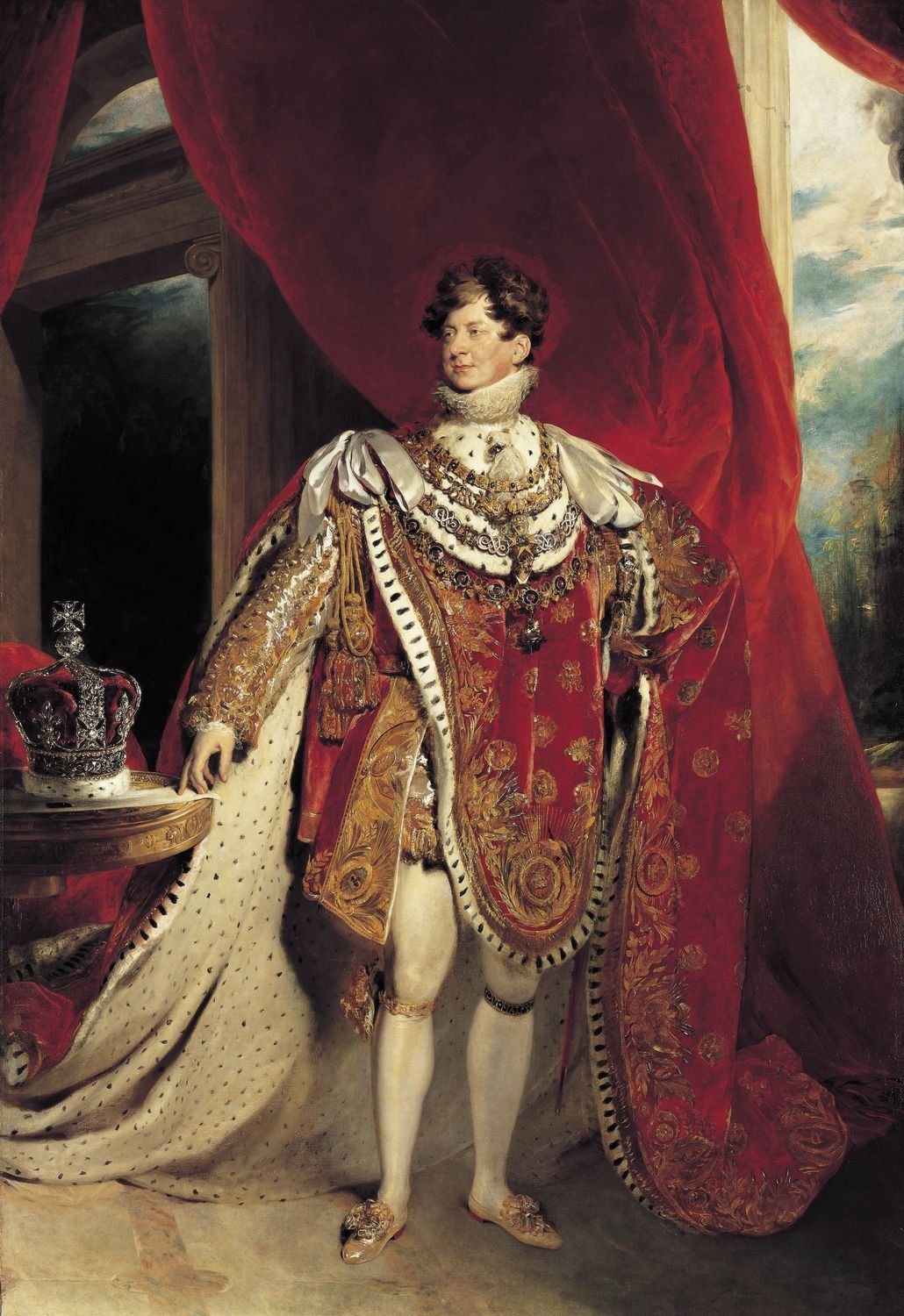
George IV
Following the death of his father, George IV was crowned as King of the United Kingdom at a delayed coronation at Westminster Abbey on 19 July 1821 (Gazette issue 17732), almost a full 18 months after ascending the throne.
After a ten year rule, King George IV expired in the early hours of Saturday 26 June 1830 (Gazette issue 18696), with the funeral taking place in St George’s Chapel, Windsor on 15 July of the same year (Gazette issue 18707).
The Gazette supplement explains how the remains of the late King lay in state in the Great Drawing Room of Windsor Castle “from Wednesday the 14th instant, at ten o'clock in the morning, to the time of interment.” It goes onto to describe the coffin being “covered with a purple velvet Pall, thereon Escocheons of the Royal Arms, with the Imperial Crown of the United Kingdom and the Royal Crown of Hanover laid thereon, was placed under a Canopy of purple cloth”.
At service, the new King William IV, who was Chief Mourner, is described as wearing “a long purple cloak, with the Star of the Order of the Garter embroidered 'thereon, wearing the Collars of the Garter, the Bath, the Thistle, St. Patrick, and of the Royal Hanoverian Guelphic Order”. At 10.30 in the evening the coffin was lowered into the subterranean passage leading to the Royal Burial Vault.
William IV
The coronation of George IV’s younger brother, King William IV, and Queen Adelaide took place on 8 September 1831 (Gazette issue 18848). After a reign of seven year, William died at Windsor Castle on 20 June 1837 with his niece Victoria succeeding him (Gazette issue 19509).
William was buried at St George's chapel after a state funeral on 8 July 1837 (Gazette issue 19519). The Gazette funeral supplement for William IV was very similar in format to that of George IV, with the lying in state, procession order and funeral service all recorded.
As the coffin was borne into St George’s Chapel, where William was laid to rest, “The Band of the Grenadier Guards commenced the Dead March in Saul” by Handel. According to The Gazette, minute guns were fired “From four o'clock in the morning until nine in the evening […]at intervals of five minutes […] until the conclusion of the ceremony.”
Queen Adelaide died on in December 1849 and was buried alongside him; the funeral was also gazetted (Gazette issue 21050).
Victoria
Following the death of her uncle William IV, Victoria became Queen at the age of 18 years old. She served as the ruling monarch for 63 years before expiring on 22 January 1901 at Osborne House on the Isle of Wight, surrounded by her children and grandchildren, including the future King, Edward VII and Kaiser Wilhelm II of Germany (Gazette issue 27269). At the time she was the longest-reigning British monarch and the longest-reigning queen regnant in history – an achievement later surpassed by her great-great-granddaughter, Queen Elizabeth II.
Victoria’s state funeral took place on 2 February 1901, much of which had already planned her funeral before her passing. In 1897, the Queen had left strict instructions relating to the service and ceremony. For example, before being placed in her coffin Victoria was dressed in a white gown and her wedding veil. She had also requested that family mementoes be placed inside, such as Albert's dressing gown and a plaster cast of his hand.
As Victoria was a soldier's daughter and head of the army, she also requested that the procession and funeral be a full military service. This meant “the Coffin was borne from the House by Her Majesty's Highlanders, and placed on a Gun Carriage” and the procession consisted of navy and army officers rather than peers, the judiciary and privy counsellors (Gazette issue 27316).
The use of a gun carriage is still tradition in both state and ceremonial funerals to this day. During the procession in Windsor, however, the gun carriage broke and could not be pulled by the horses. Therefore, sailors from HMS Excellent were ordered to transport the carriage the rest of the way to the chapel with ropes. This has also subsequently become a tradition of state funerals.
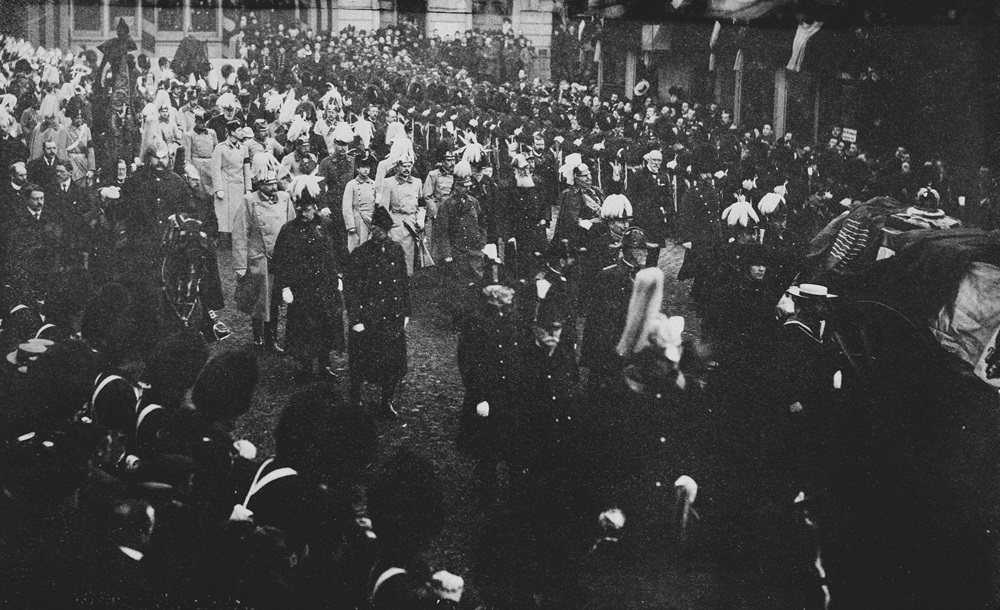
The sailors who helped with the gun carriage were awarded the Royal Victorian Medal for their services. The Royal Victorian Medal was also given to the men who helped with the gun carriage part of the later ceremonial. More than 300 medals were awarded after each funeral in connection with the duties performed in 1910, 1936 and 1952. The Gazette also recorded the 180 or so medals that were conferred in connection with the movements of the late Queen Elizabeth II's coffin (Gazette issue 64008).
As the Queen Victoria died on the Isle of Wight, her body was carried on board the HMY Alberta with several yachts taking mourners, as well as the new King, to Gosport in Hampshire and then by train to Victoria station in London. The procession then began on the route from Victoria to Paddington station as “Eighty-one Minute Guns were fired”. From Paddington, the train conveyed the coffin to Windsor.
On arriving at Windsor, the Coffin, “covered by a Pall of white satin and the Royal Standard, on which rested the Cushion and Crown, the Regalia, and Insignia of the Order of the Garter” was removed from the train “and placed upon a Gun Carriage drawn by eight horses of the Royal Artillery”.
At the service at St George’s Chapel, the new King Edward VII, who was Chief Mourner, stood at the head of the coffin. After the Garter Principal King of Arms had proclaimed the Queen's styles and titles, “The Anthem "Blessed are the departed," was then sung, and the Archbishop of Canterbury pronounced the Benediction.”
Queen Victoria's body lay in state at St George’s Chapel for two days, before the coffin was carried on the evening of 4 February to Frogmore Mausoleum, which she had built for Albert upon his death. During a short service, “Earth was cast upon the Coffin by Colonel Lord Edward Pelham Clinton, K.C.B. (Master of the Household to Her late Majesty)”, “The Prayers were read by the Dean of Windsor” and “a Prayer of Thanksgiving and the Benediction were pronounced by the Bishop of Winchester.” Victoria was the first monarch to be buried outside of Westminster Abbey and St George's Chapel since King George I, 174 years before.
Edward VII
King Edward VII expired at Buckingham Palace on the evening of Friday 6 May 1910 (Gazette issue 28365), with a public lying in state starting from 17 May 1910 and his funeral taking place on 20 May (Gazette issue 28401).
According to The Gazette, during the lying in state at Westminster Hall, “Four Gentlemen at Arms stood at the head of the Coffin, and four Yeomen of the Guard stood at the four corners of the Catafalque. Two Officers of the Household Cavalry and Brigade of Guards were also stationed on either side, and a native Orderly Officer of the Ghurka Rifles at the foot of the Coffin.” It was the first time a monarch had lain in state in the Westminster Hall and something both Edward’s son and grandson would also do.
The funeral procession began at “precisely” 9.45 on the morning of 20 May 1910. Edward’s coffin was “placed upon a Gun Carriage, and the Crown and Cushion, the Regalia, and the Insignia of the Garter laid thereon” before the procession headed to Paddington Station. It’s estimated that between three and five million people gathered in London to watch the procession.
The coffin arrived in Windsor where the coffin “was removed from the train by the Bearer Party of the Brigade of Guards, and placed upon a Gun Carriage drawn by the Royal Navy” before the procession made its way to St George's Chapel at Windsor Castle.
The new King George V and Queen Alexandra stood at the head of the coffin during the funeral service, while the likes of the Emperor of Germany, the King of Spain and the King of Norway were also in attendance. The Gazette supplement provides details on the order of the service before describing how the “Company Colour of the King's Company of the Grenadier Guards” was placed on Edward VII’s coffin by George V before the coffin was lowered into the grave.

George V
George V died at his home in Sandringham, Norfolk just before midnight on 20 January 1936 (Gazette issue 34244). He was interred at St George's Chapel, Windsor Castle following a funeral on 28 January 1936 (Gazette issue 34279).
As described in The Gazette, on Tuesday 21 January “the Coffin containing the Royal
Remains was taken to Sandringham Parish Church, and lay there, guarded by men employed
on the Royal Estate at Sandringham, one standing at each corner of the Bier” until
Thursday 23 January when the late King’s coffin, which “was made of Oak cut on the
Sandringham Estate” and “covered by the Royal Standard” was taken to Wolferton Station
after a short service conducted by the Bishop of Norwich and the Reverend Arthur Rose
Fuller, Rector of Sandringham.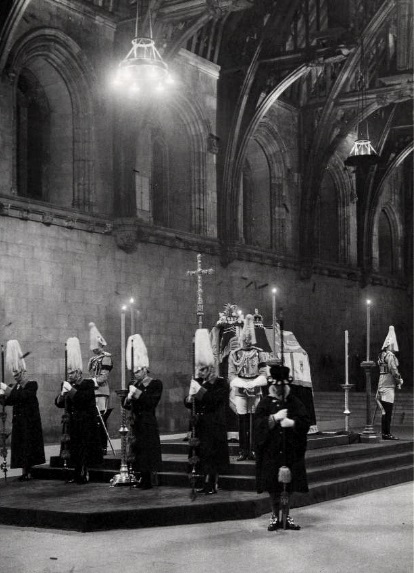
On arrival at King's Cross Station, the “Royal Coffin was removed by an Officer and ten men of the King's Company Grenadier Guards and placed upon a Gun Carriage drawn by " F " Battery, Royal Horse Artillery”. The Imperial Crown was placed on the coffin, which moved in procession to Westminster Hall for the lying in state. During the procession the Maltese Cross fell off the Imperial Crown.
Though not recording in The Gazette, the night before the funeral the late King’s four sons, Edward, Albert, Henry, and George took guard at the lying in state and held an all-night vigil for their father in Westminster Hall. This has since become known as the ‘Vigil of the Princes’.
The following day, the funeral procession made its way through the streets of London towards Paddington Station when the coffin was the taken to Windsor. According to The Gazette, following a procession to St George's Chapel, the “Royal Remains” were received at the West Door by The Archbishop of Canterbury, The Archbishop of York, The Bishop of Winchester (Prelate of the Order of the Garter), The Bishop of Oxford (Chancellor of the Order of the Garter) and The Dean of Windsor (Register of the Order of the Garter).
The new King Edward VIII, who would abdicate before the year was over, stood at the head of the coffin for the burial service. During the service, the hymn “Abide with me” was sung and the Sentence "I heard a Voice from Heaven" was also sung by the Choir. As the sentence of commital to the grave was read by the Archbishop of Canterbury, “earth was cast upon the Coffin by The King”.
Queen Mary was laid to rest next to her husband following her funeral on 31 March 1953.
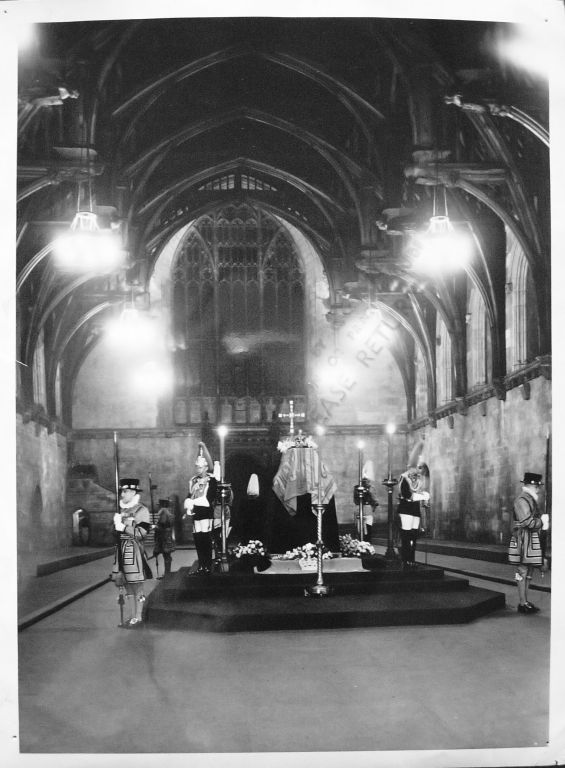
George VI
Following Edward VIII’s abdication on 11 December 1936, George VI ascended the throne. He reigned until 6 February 1952 when, at the age of 56, he died at Sandringham of a coronary thrombosis (Gazette issue 39458). Queen Elizabeth II ascended the throne. George VI’s funeral took place on 15 February 1952 with The Gazette once again recording proceedings (Gazette issue 39575).
After 5 days of lying in state at St Mary Magdalene Church, Sandringham, the royal coffin arrived in London on Monday 11 February. Upon arrival at 2.45, the Royal Coffin “was placed upon a Gun Carriage drawn by the King's Troop, Royal Horse Artillery” and the “Imperial State Crown was placed upon the Coffin”. It then moved in procession to Westminster Hall with The Duke of Edinburgh and The Duke of Gloucester walking immediately behind. While lying in state, it’s estimated that over 300,000 members of the public passed through Westminster Hall.
At 9.30 on 15 February “the Royal Coffin, covered by the Royal Standard, and with the Crown, Sceptre and Orb laid thereon, was removed from Westminster Hall by a Bearer Party of the King's Company, Grenadier Guards and placed upon a Gun Carriage drawn by Naval Ratings.” Led by the Band of the Royal Air Force and the Band of the Welsh Guards, the procession moved to Paddington Station while “Fifty-six Minute Guns were fired”.
Upon arrival at Windsor, a smaller procession moved to St George's Chapel as “Minute Guns were fired in the Long Walk”. George VI was buried within the Royal Vault at St George's Chapel. The funeral was the first of a British monarch to be televised, though filming was not permitted at the funeral service.
Elizabeth II
After reigning for 70 years, more than any other British monarch, Queen Elizabeth II died peacefully at Balmoral Castle during the afternoon on 8 September 2022 (Gazette issue 63808). As is now custom, the ceremonials observed for the arrival of the remains of her late Majesty Queen Elizabeth II for the lying in state, as well as her funeral and commital service, was recorded in a supplement of The Gazette (Gazette issue 64462).
The supplement begins by recording how “On Wednesday 14 September, Guards of Honour found by the Foot Guards, and by the Royal Navy, the Foot Guards, and the Royal Air Force were mounted at Buckingham Palace and Parliament Square respectively” for the arrival of the late Queen’s remains at Westminster Hall.
The coffin, which was “draped with the Royal Standard on which was placed the Imperial State Crown on a velvet cushion and a Wreath of Flowers” was carried by the Bearer Party of The Queen’s Company 1st Battalion Grenadier Guards from the Bow Room of Buckingham Palace and placed upon a Gun Carriage before moving in Procession to Westminster Hall at 14.22. As the Procession moved, “Minute Guns were fired from Hyde Park by The King’s Troop Royal Horse Artillery and Big Ben tolled at 1-minute intervals.” It arrived at Westminster Hall at 15.00 and a short service was conducted the Archbishop of Canterbury, “assisted by the Dean of Westminster”.
The lying in state lasted from the evening of 14 September until 06.30 of Monday 19 September, where it’s estimated over 250,000 members of the public came to pay their respects to the late Queen.
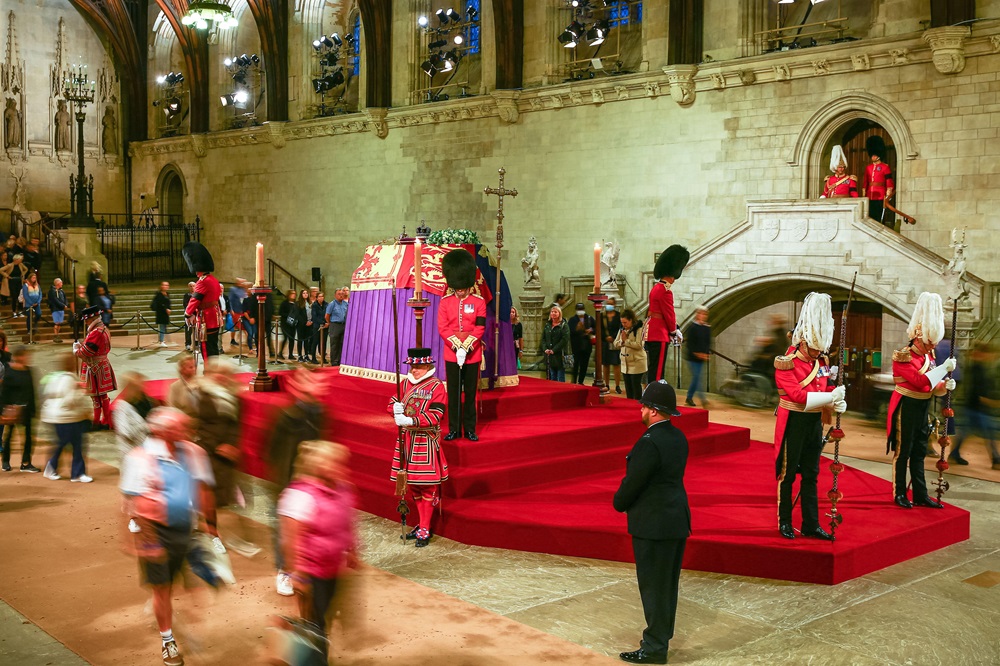
At 10.37 on Monday 19 September, the coffin, which was now “draped with the Royal Standard, upon which the Imperial State Crown and Regalia of the Orb and the Sceptre along with a Wreath of Flowers”, was removed from Westminster Hall and “placed upon the State Gun Carriage of the Royal Navy drawn by Naval Ratings” by the Bearer Party and moved in procession to Westminster Abbey for the state funeral. This was the first time that the funeral service and commital service, which would take place in Windsor later in the day, took place at different venues.
On arrival at Westminster Abbey, the coffin “was lifted from the Gun Carriage by the Bearer Party and moved through the West Gate towards the Great West Door.” It was “preceded by the Pall Bearers found from former Equerries to The Queen and followed by HIS MAJESTY THE KING and other Members of the Royal Family.” The coffin entered the abbey at 11.00 “while the Sentences were sung by The Choir.”
The state funeral service was conducted by the Dean of Westminster, during which “Lessons were read by the Secretary-General of the Commonwealth and the Prime Minister” and “Prayers were said by the Archbishop of York, the Cardinal Archbishop of Westminster, the Moderator of the General Assembly of the Church of Scotland and the Free Churches Moderator.” To mark the end of the service, “Last Post was sounded, and The Sovereign’s Piper played a Lament.” A two minute’s silence was then observed and “the National Anthem drew the Service to a close.”
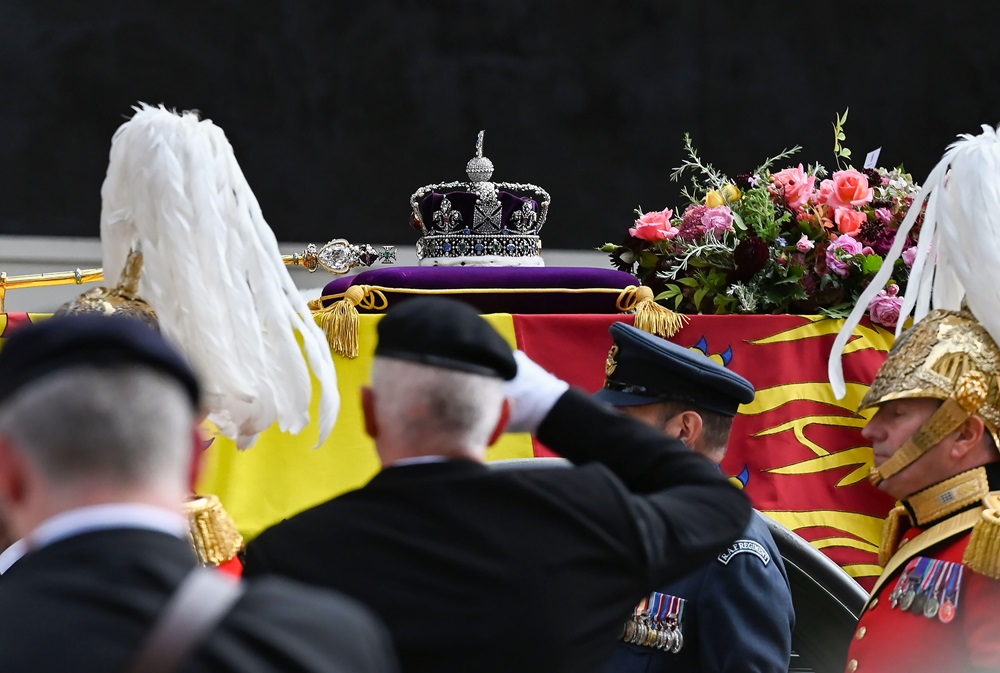
The coffin then moved in procession to Wellington Arch, Apsley Way, where it arrived at 13.40. It was then placed in the State Hearse by the Bearer Party. The Gazette describes how as the coffin procession moved to Windsor “the Parade gave a Royal Salute and the National Anthem was played, while the King’s Troop Royal Horse Artillery depressed the barrels of the Guns.”
At 15.10, the coffin moved in procession “from Albert Road, Windsor to St. George’s Chapel, Windsor Castle” while “Minute Guns were fired by The King’s Troop Royal Horse Artillery” from Windsor Castle and the “Sebastopol Bell and the Curfew Tower Bell tolled once every minute.” The Gazette notes how King Charles III and other members of the Royal Family joined the procession at the Quadrangle at Windsor Castle.
On arrival at St George’s Chapel, “the Coffin Procession moved up the Nave.” The commital service was conducted by the Dean of Windsor and featured “the Kontakion sung by the Choir of St George’s Chapel”, also sung at the funeral of Prince Philip, as well as the hymns “All my hope on God is founded” and “Christ Is Made the Sure Foundation”. Before the coffin was lowered, King Charles III placed The Queen’s Company Camp Colour on it, followed by the Lord Chamberlain “breaking his Wand of Office and placing it upon the Coffin.”
As the coffin was lowered, “the Dean of Windsor read Psalm 103: 13–17, followed by the Commendation “Go forth upon thy journey from this world, O Christian soul”.” Garter Principal King of Arms then pronounced the Styles of Her late Majesty, followed by the Sovereign’s Piper playing a Lament. “The National Anthem drew the Service to a close” as “all remained standing as HIS MAJESTY THE KING and The Queen Consort” departed.
The Gazette also recorded that “contrary to custom, “GOD SAVE THE KING” was not proclaimed” at the end of the service.
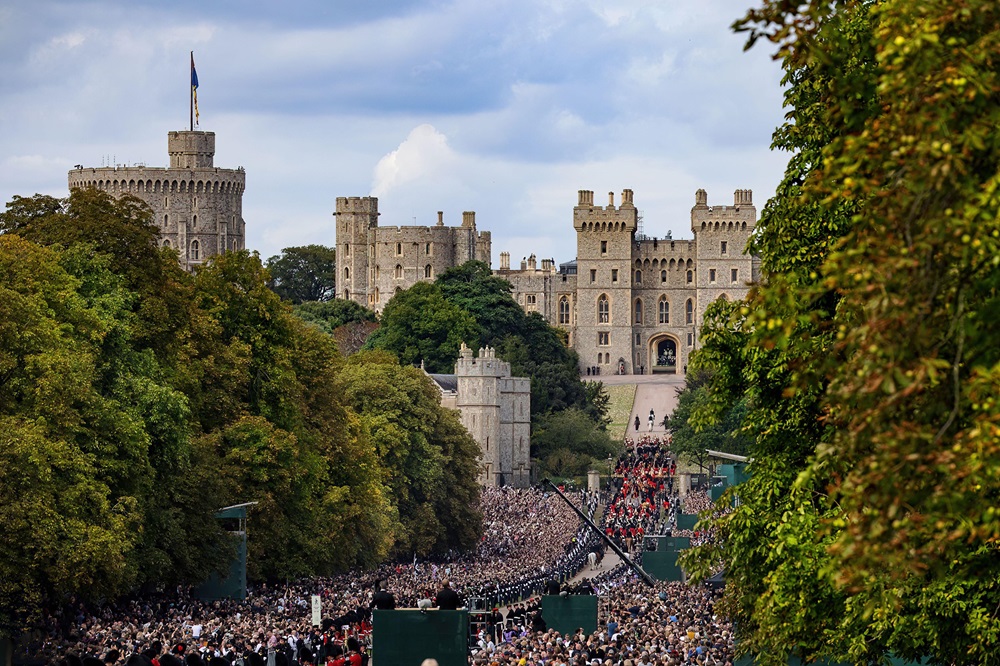
See also
Gazette Firsts: The history of The Gazette and royal coronations
Queen Elizabeth II - In Memoriam
Images
The Gazette
Getty Images
Royal Collection Trust / © His Majesty King Charles III 2024
Royal Collection Trust / © His Majesty King Charles III 2024
Royal Collection Trust / © His Majesty King Charles III 2024
Royal Collection Trust / © His Majesty King Charles III 2024
The House of Windsor
Royal Collection Trust / © His Majesty King Charles III 2024
Alamy
Alamy
Alamy
Publication date
18 July 2024
Any opinion expressed in this article is that of the author and the author alone, and does not necessarily represent that of The Gazette.
